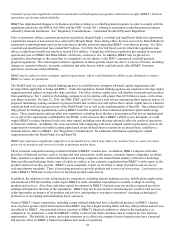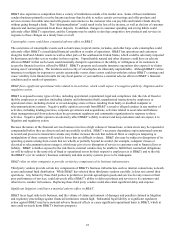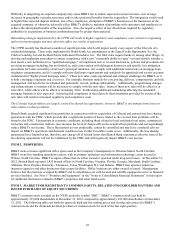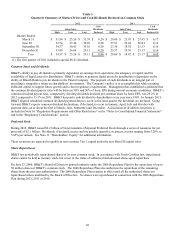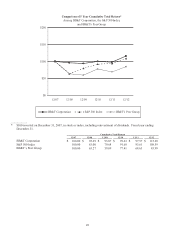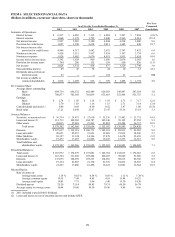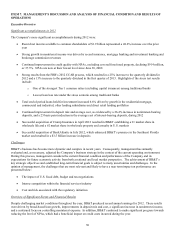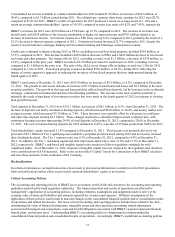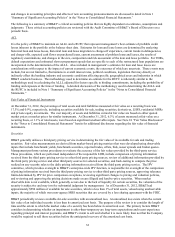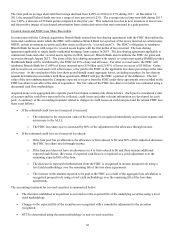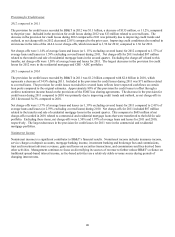BB&T 2012 Annual Report Download - page 54
Download and view the complete annual report
Please find page 54 of the 2012 BB&T annual report below. You can navigate through the pages in the report by either clicking on the pages listed below, or by using the keyword search tool below to find specific information within the annual report.
32
and changes in accounting principles and effects of new accounting pronouncements are discussed in detail in Note 1
“Summary of Significant Accounting Policies” in the “Notes to Consolidated Financial Statements.”
The following is a summary of BB&T’ s critical accounting policies that are highly dependent on estimates, assumptions and
judgments. These critical accounting policies are reviewed with the Audit Committee of BB&T’ s Board of Directors on a
periodic basis.
ACL
It is the policy of BB&T to maintain an ALLL and a RUFC that represent management’ s best estimate of probable credit
losses inherent in the portfolio at the balance sheet date. Estimates for loan and lease losses are determined by analyzing
historical loan and lease losses, historical loan and lease migration to charge-off experience, current trends in delinquencies
and charge-offs, expected cash flows on purchased loans, current assessment of problem loans and leases, the results of
regulatory examinations, and changes in the size, composition and risk assessment of the loan and lease portfolio. For TDRs,
default expectations and estimated slower prepayment speeds that are specific to each of the restructured loan populations are
incorporated in the determination of the ALLL. Also included in management’ s estimates for loan and lease losses are
considerations with respect to the impact of current economic events, the outcomes of which are uncertain. These events may
include, but are not limited to, fluctuations in overall interest rates, political conditions, legislation that may directly or
indirectly affect the banking industry and economic conditions affecting specific geographical areas and industries in which
BB&T conducts business. The methodology used to determine an estimate for the RUFC is inherently similar to the
methodology used in calculating the ALLL adjusted for factors specific to binding commitments, including the probability of
funding and exposure at the time of funding. A detailed discussion of the methodology used in determining the ALLL and
the RUFC is included in Note 1 “Summary of Significant Accounting Policies” in the “Notes to Consolidated Financial
Statements.”
Fair Value of Financial Instruments
At December 31, 2012, the percentage of total assets and total liabilities measured at fair value on a recurring basis was
17.3% and 0.9%, respectively, including securities available for sale, trading securities, derivatives, LHFS, residential MSRs
and private equity investments. The vast majority of assets and liabilities carried at fair value are based on either quoted
market prices or market prices for similar instruments. At December 31, 2012, 6.3% of assets measured at fair value on a
recurring basis, or 1.1% of total assets, were based on significant unobservable inputs. See Note 18 “Fair Value Disclosures”
in the “Notes to Consolidated Financial Statements” herein for additional disclosures regarding the fair value of financial
instruments.
Securities
BB&T generally utilizes a third-party pricing service in determining the fair value of its available for sale and trading
securities. Fair value measurements are derived from market-based pricing matrices that were developed using observable
inputs that include benchmark yields, benchmark securities, reported trades, offers, bids, issuer spreads and broker quotes.
Management performs various procedures to evaluate the accuracy of the fair values provided by the third-party service.
These procedures, which are performed independent of the responsible LOB, include comparison of pricing information
received from the third party pricing service to other third party pricing sources, review of additional information provided by
the third party pricing service and other third party sources for selected securities, and back-testing to compare the price
realized on any security sales to the daily pricing information received from the third party pricing service. The IPV
committee, which provides oversight to BB&T’ s enterprise-wide IPV function, is responsible for oversight of the comparison
of pricing information received from the third party pricing service to other third party pricing sources, approving tolerance
limits determined by IPV for price comparison exceptions, reviewing significant changes to pricing and valuation policies,
and reviewing and approving the pricing decisions made on any illiquid and hard-to-price securities. When market
observable data is not available, which generally occurs due to the lack of liquidity for certain securities, the valuation of the
security is subjective and may involve substantial judgment by management. As of December 31, 2012, BB&T had
approximately $994 million of available for sale securities, which is less than 1% of total assets, valued using unobservable
inputs, the majority of which were non-agency MBS securities that are covered by a loss sharing agreement with the FDIC.
BB&T periodically reviews available-for-sale securities with an unrealized loss. An unrealized loss exists when the current
fair value of an individual security is less than its amortized cost basis. The purpose of the review is to consider the length of
time and the extent to which the market value of a security has been below its amortized cost. The primary factors BB&T
considers in determining whether an impairment is other-than-temporary are long-term expectations and recent experience
regarding principal and interest payments, and BB&T’ s intent to sell and whether it is more likely than not that the Company
would be required to sell those securities before the anticipated recovery of the amortized cost basis.


